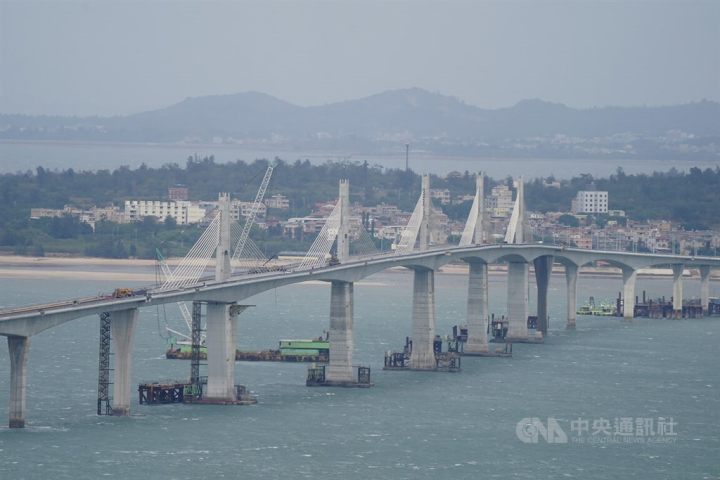
Taipei, Oct. 30 (CNA) The Kinmen Bridge opened to traffic Sunday, bringing to an end a seemingly interminable saga of controversy, delays, contractor issues and technical challenges that had plagued the ambitious project first proposed nearly three decades ago.
A long line of cars and tour buses eager to give the 5.4-kilometer bridge a try packed the westbound lane headed from Kinmen Island to its smaller neighbor Lieyu after the bridge formally opened to traffic at 3 p.m.
Only ferries have connected the two main islands in the Kinmen Island chain in the past, and Kinmen County Magistrate Yang Chen-wu (楊鎮浯) said the bridge would change the lives of those living in Lieyu and reduce the risks of living there.
"From this point on, the people of Lieyu will no longer be at the mercy of the weather in a medical emergency and their access to daily necessities will be ensured," Yang said at a ceremony Sunday morning that formally declared the bridge open.
"This bridge has carried the hopes of the past, achieved the dreams of the present, and will promote the prosperity of the future," he said.
With its opening, the 5.4-kilometer structure, of which 4.8 kilometers is routed over water, took its place as Taiwan's longest sea bridge, easily supplanting the 2.5-km long Penghu Trans-Oceanic Bridge connecting Baisha and Xiyu islands in the Penghu archipelago.
The NT$9.66 billion (US$300 million) bridge's final hurdle was cleared Friday after last-minute improvements were made to traffic-related infrastructure by the contractor, Kaohsiung-based Dong Pi Co., and confirmed by the Freeway Bureau.
Happy to see the project come to fruition, Dong Pi Chairman Wang Yin-he (王銀和), 71, said that thanks to the Kinmen Bridge, he had finally achieved his "magnum opus" after being in the construction business for 47 years.
It was a long time coming, for him and for those living in Kinmen County, which lies off the coast of southeastern China just kilometers from the Chinese coastal city of Xiamen.
The bridge, which connects Houtou in Lieyu Township (also known as Little Kinmen) to Huxia in Jinning Township on the main island of Kinmen, was originally proposed in 1993 as a solution to improve transportation between the two islands.
The project quickly gained the reputation, however, as nothing more than a political tool, something politicians merely gave lip service to at election time rather than a viable vision.
After many stops and starts, the county government finally decided in 2009 to go ahead with the plan to build the bridge, whose main purpose at this point had shifted from improving transportation to boosting tourism, and sent it to the Cabinet for review.
In 2010, the Cabinet approved the plan and opened it to bids the same year. A groundbreaking ceremony was attended by then-President Ma Ying-jeou (馬英九) in January 2011.
The bid to build the bridge's on-ramps went to the bridge's first contractor, Ho-Long Civil Construction Co., which completed the work in May 2012.
After that was when the problems occurred.
The second contractor, Hua Chi Construction Co., which had won the bid to build the bridge's main span, saw its work suspended and contract terminated in December 2012 after it was found to not be qualified for the project.
Construction work resumed when a third contractor, Kuo Teng Construction Co., was signed on in May 2013.
In March 2016, then-Premier Simon Chang (張善政) expressed displeasure over a delay in the bridge's construction, but the problem persisted, leading to the dissolution of the contract with Kuo Teng in June 2016.
The situation improved after Dong Pi, the fourth and final contractor, took over the project in November 2016. It has since been responsible for the bridge's piles, cables, and installation of its girders, which was completed in July this year, giving the bridge a full deck.
Construction manager Kao Cheng-ting (高正廷) told CNA that the project faced many challenges, including punching through the granite seabed underneath the piles while overcoming powerful sea currents, tidal ranges, fog, and strong northeasterly trade winds.
That was not surprising for a project encompassing its on-ramps and decks, 11 pylons and 532 piles installed across a span of water that was up to 23 meters deep and had a maximum tidal range of 6 meters, according to the Kinmen County Public Works Bureau.
To erect the bridge's piles and pile caps in the water, for example, steel cofferdams were built, the first time any bridge in Taiwan was built using this construction method, according to the Kinmen County Public Works Bureau.
The transportation of 376 girders from Kaohsiung's Xingda Harbor where they were molded to Kinmen County was also problematic because of the unpredictability of sea transport, the bureau said.
The contractor had to add to two Singaporean-flagged crane vessels weighing 800 tonnes and 650 tonnes respectively to its existing fleet of three large barges and two tugboats to meet the challenge, the bureau said.
Kao said managing workers was also an issue, given that a team of 500 workers was needed at the height of construction when the project was most challenging, which then gradually dropped to about 200 after the challenges were met.
Ultimately, even though the central government was supposed to finance two-thirds of the bridge's costs, it ended up funding only 49 percent of the project's NT$9.66 billion bill, according to Kinmen County Council Speaker Hung Yun-tien (洪允典).
On Sunday, however, those living in Kinmen seemed to care little how the bridge was funded or the difficulties in completing it. When the first cars drove on the bridge, their feelings were summed up with a simple sense of relief: "It's finally open."